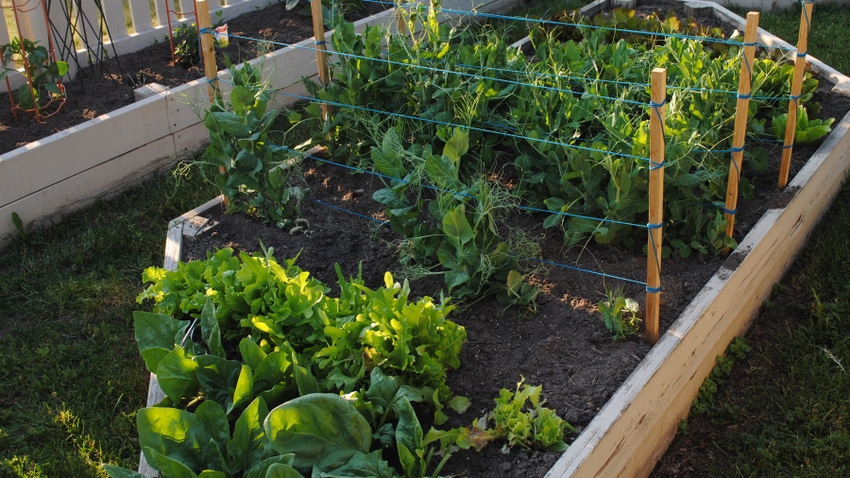
After a long winter, I can’t think of anything more life renewing than playing in the dirt, getting your hands dirty and planting some vegetables. Not only is it fun to watch vegetables grow, but it’s also very rewarding to be able to produce your own food. Homegrown vegetables are healthy for your family to eat.
I am a lifelong gardener. When I was a kid, I remember helping my parents plant a garden every year. I pulled weeds and helped pick peas, green beans and strawberries. But my favorite part was just being able to walk out in the garden each day and grab a handful of green beans or cherry tomatoes to eat whenever I felt like it.
I took gardening as a 4-H project and showed vegetables at the county fair every year. In later years, our four sons did the same thing. Now that we are empty nesters, my favorite part of gardening is being able to grow fresh, healthy vegetables that my husband and I enjoy.
Here are 10 tips for how to start growing a vegetable garden:
1. Start small and work your way up. You don’t have to plant a huge vegetable garden to grow vegetables. In fact, small spaces work just fine, especially if you don’t have kids living at home. We all have busy lives, and there just isn’t enough time to plant and maintain a huge garden unless you have help. If you only want to plant an 8-by-8-foot garden, then go for it.
2. Decide if you want a raised garden bed. I like raised garden beds. They look neat and tidy in a yard. You can prepare a perfect mixture of soil and composted manure that the plants will thrive in. Plus, being raised makes weeding and harvesting vegetables easier on your back and knees. If you are growing a large garden, it’s easier to plant straight into the ground.
3. Choose a sunny place to grow your garden. Don’t plant your garden in a shady area. The more sun, the better, but if you can find a spot that has at least six hours of sunshine each day, your garden should grow well.
4. Select a spot where the garden hose or sprinkler will reach. Don’t plant your garden somewhere where you have to carry buckets of water to keep the soil moist. Make sure the hose or sprinkler will reach the area. Vegetable gardens need at least 1 inch of water a week, and more during dry spells and high heat.
5. Plant when it’s safe to plant. You can plant peas, onions, potatoes, broccoli and Brussels sprouts in early April in southern Wisconsin. In fact, these plants prefer cooler temperatures and will grow better when planted early. They can handle frost and even a little snow. Make sure you wait until the risk of frost is gone to plant sensitive plants like tomatoes, squash, melons, pumpkins, green beans and cucumbers. In southern Wisconsin, that is after Mother’s Day. Check with a garden center to find out when the threat of frost is gone in your area.
6. Plant vegetables your family will eat. Don’t plant radishes or Swiss chard if you don’t like eating them. Don’t plant five or six zucchini plants unless you really like zucchini. Focus on what your family eats. I like a lot of tomatoes, so half of our garden is filled with tomatoes. We like cherry and yellow plum tomatoes as well as medium and large tomatoes for salads, sliced tomatoes, roasted tomatoes and my family’s all-time favorite — fried green tomatoes. Tomatoes never go to waste at our house.
7. Choose easy-to-grow vegetables. Cherry tomatoes and yellow plum tomatoes are a safe bet, even for beginners. Lettuce, onions, bell peppers, green beans and parsley are pretty much foolproof too. A lot of people are growing salsa gardens — gardens that provide the ingredients for salsa, such as Roma tomatoes, onions and bell peppers. Roma tomatoes work best because they are a meaty tomato with less liquid, which makes thicker salsa.
8. Prepare the soil. Your soil should be high in nutrients and well drained. If you are planting in the ground, add composted manure to the soil each year to make sure plants have enough nutrients to grow. But don’t go overboard. Too much compost can “burn” plants like tomatoes. Make sure your compost and soil are free of weed seeds. It may be worth it in the long run to purchase bags of compost and topsoil at the garden center. For raised garden beds, use a mixture of compost, topsoil and a little peat moss.
9. Use the right tools. You really don’t need a lot of tools. A hoe, a garden rake, a shovel, a trowel, a watering can and gloves are the only tools you really need to start a garden. A tiller is also nice, and a borrowed tiller is even better! Don’t invest in a tiller until you have gardened for at least a year, and you know you like gardening.
10. Harvest what you grow. Take time to harvest your crops. Eat vegetables fresh from the garden, or can or freeze them for later. If you are too busy to harvest green beans, tomatoes or lettuce, invite a relative, friend or neighbor to help you.
If you have questions, don’t be afraid to ask someone who gardens for advice. But one of the best ways to learn is by trial and error. Involve your kids in helping with the garden. Gardening is great exercise for the whole family and a good way to get your kids to eat homegrown vegetables. Plant a garden, water it and see what grows!
About the Author(s)
You May Also Like






